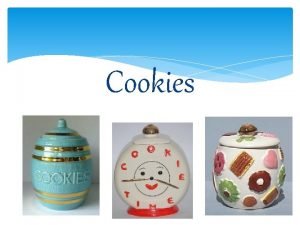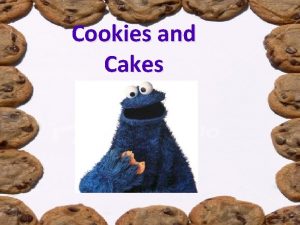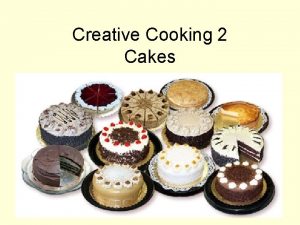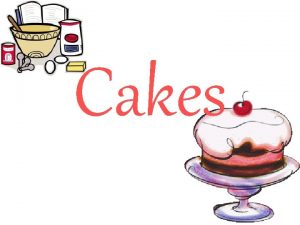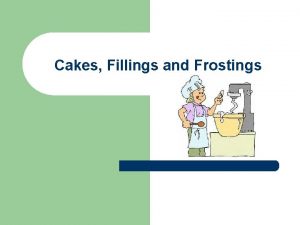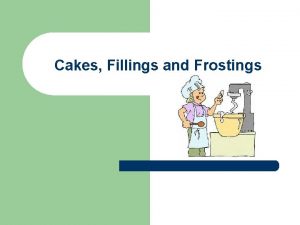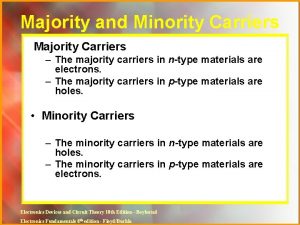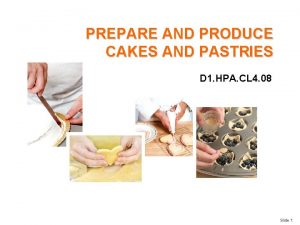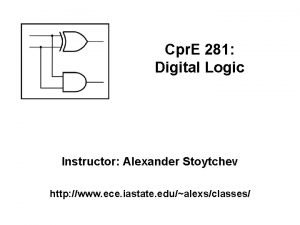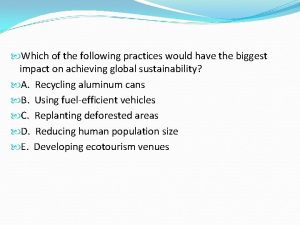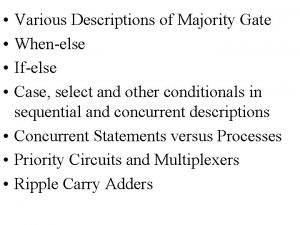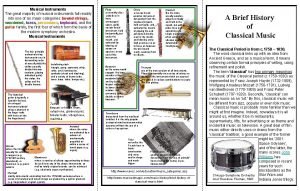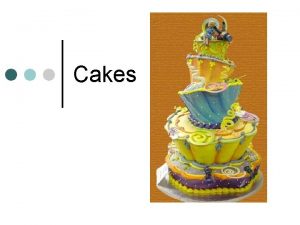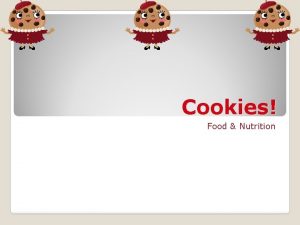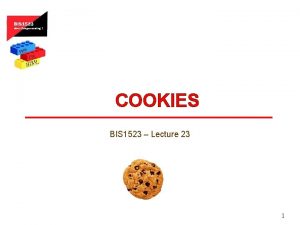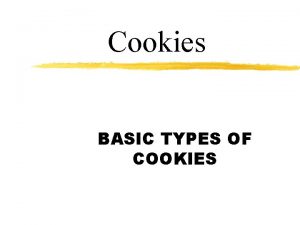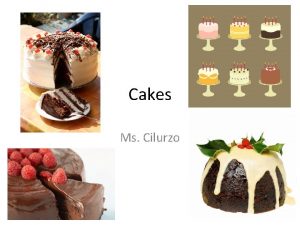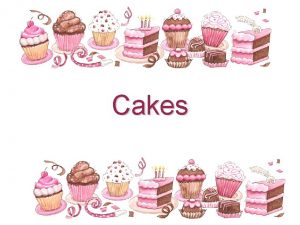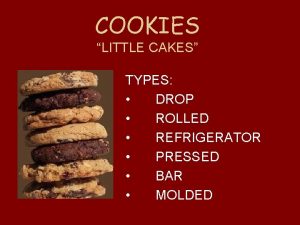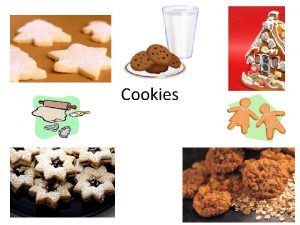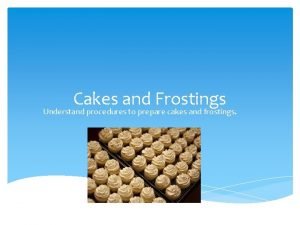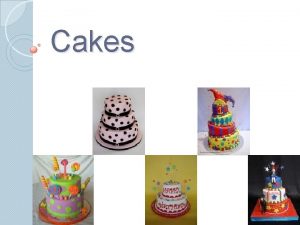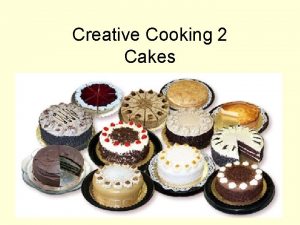Cakes and Cookies Types of Cakes The majority






























- Slides: 30

Cakes and Cookies

Types of Cakes • The majority of cakes are: • Shortened • Unshortened • Chiffon

Types of Cakes • Shortened cake: A cake made with fat.

Types of Cakes • Unshortened cake: A cake made without added fat.

Types of Cakes • Chiffon cake: A cake made by combining the characteristics found in both shortened and unshortened cakes.

Mixing Techniques • “Mixing” is a general term that includes beating, blending, binding, creaming, whipping, and folding. • In mixing, two or more ingredients are evenly dispersed in one another until they become one product.

Mixing Techniques • Beat: • Blend: • Bind: • Cream: • Whip: • Fold:

Mixing Techniques • There are many methods for combining the ingredients of cakes and other baked products, but the most commonly used are the conventional creaming), conventional sponge, single-stage (quick-mix), pastry-blend, biscuit, and muffin methods.

Mixing Techniques • Conventional (Creaming) Method • The most time consuming, and is the method most frequently used for mixing cake ingredients. • It produces a fine-grained, velvety texture. • The three basic steps are: • 1. ) Creaming • 2. ) Egg incorporation • 3. ) Alternate addition of the dry and moist ingredients

Mixing Techniques • Conventional Sponge Method • Identical to the creaming method except that a portion of the sugar is mixed in with the beaten egg or egg white, and the egg foam is folded into the batter in the end.

• Single-Stage Method • Also known as the quick-mix, onebowl, or dump method. • All the dry and liquid ingredients are mixed together at once. • Packaged mixes for cakes, biscuits, and other baked goods rely on this method.

Mixing Techniques • Pastry-Blend Method • Fat is first cut into flour with a pastry blender, or with two knives crisscrossed against each other in a scissor-like fashion, to form a mealy fat-flour mixture. • Half the milk and all of the sugar, baking powder, and salt are then blended into the fatflour mixture. • Lastly, eggs and more milk may then be blended into the mixture.

Mixing Techniques • Muffin Method • This is a simple, two-stage mixing method. • The dry and moist ingredients are mixed separately and then blended until the dry ingredients just become moist. • Over-mixing will result in a tough baked product riddled with tunnels.

Preparation of Cakes • • Ingredients proportion differ from bread Flour Sugar Fat Eggs Milk Leavening

Type of pans • Unshortened • Shortened

Preparation of Cakes • The timing of pouring the cake batter and getting it into a properly heated oven is another important factor in cake quality.

Preparation of Cakes • When shortened cakes are nearing doneness, they start to “wrinkle” at the pan edges.

Preparation of Cakes • When unshortened cakes are done the surface is lightly brown and springs back when touched

Preparation of Cakes • Once the shortened cake is done, it should be removed gently from the oven and allowed to cool on a rack for 5 or 10 minutes.



Preparation of Cakes • As in bread preparation, cake ingredients must be modified at altitudes higher than 3, 000 feet.

Baking adjustments, pre and post

Storage of Cakes • The amount and type of sweetener used in the preparation of a cake affects its ability to be stored. • Cakes stale fairly quickly.

Types of Cookies • Not all fit neatly into one classification. • The fluidity of the batter or dough determines which of the following six categories cookies fall into: • Bar • Dropped • Pressed • Molded • Rolled • Icebox/refrigerator


Types of Cookies • Dropped cookie batter is literally dropped onto the baking sheet. • The batter contains just enough flour so the cookie will not spread out like a pancake when it is dropped on the baking sheet.

Preparation of Cookies Mixing Methods • The type of cookie to be prepared determines the mixing method, but for most types the conventional cake method is used. • Once the ingredients are chosen based on whether a flat or puffy cookie is desired, they are usually just barely mixed together until moistened.


Storage of Cookies • Airtight containers are best for maintaining cookie freshness. • As soon as the cookies are cooled they are transferred to a flat dish or plate and covered with plastic wrap or metal foil.
 6 types of cookies and examples
6 types of cookies and examples Types of cookies texture
Types of cookies texture Unshortened cake examples
Unshortened cake examples Four types of cakes
Four types of cakes A cross between shortened and unshortened cakes
A cross between shortened and unshortened cakes Shortened cake examples
Shortened cake examples Majority and minority carriers
Majority and minority carriers Prepare and produce cakes and pastries
Prepare and produce cakes and pastries Edible plate boundaries
Edible plate boundaries Cookies frames and frame busting
Cookies frames and frame busting Cookies frames and frame busting
Cookies frames and frame busting Oreo tectonic plates
Oreo tectonic plates 3 behaviours that enable a minority to influence a majority
3 behaviours that enable a minority to influence a majority Hazelwood v kuhlmeier amendment
Hazelwood v kuhlmeier amendment What are forms of government
What are forms of government Majority circuit
Majority circuit 3 input majority circuit
3 input majority circuit Band gaps of semiconductors
Band gaps of semiconductors Any deviation from the average or from the majority
Any deviation from the average or from the majority Define delimit demarcate administrate
Define delimit demarcate administrate Gate cs
Gate cs Three input majority function
Three input majority function Majority
Majority Paragraph about office work
Paragraph about office work The vast majority of hindus live in:
The vast majority of hindus live in: Which of the following practices
Which of the following practices Whenelse
Whenelse Double majority
Double majority Majority vote circuit
Majority vote circuit The term “minority majority” refers to the fact that
The term “minority majority” refers to the fact that Ilocano name for the wind instrument
Ilocano name for the wind instrument
